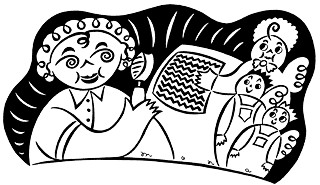Climbing the Family Tree
Everyone Counts in the Census
By Virginia B. Wood, Fri., Feb. 11, 2000

When my sisters and I began investigating our family history, we could tell from birth and death dates in an old family Bible that brothers Will and David Kelly were born in 1868 and 1870 and that their parents died within six months of each other in 1872-73. I knew the little boys grew to adulthood because Will Kelly was our great-grandfather, but I had no idea how Edney Jane and John Kelly died or who made a home for their young sons afterward. That missing piece of information nagged at me for months until a helpful family history librarian in Hunt County introduced me to the wonderful world of federal census records. The federal government has been gathering population census information every 10 years since 1790, and they're gearing up to take the 2000 census just now. Census numbers provide the information necessary to draw congressional districts, appropriate funding for various government programs, and track shifts in population demographics across the country. If making sure every household is correctly represented to the government isn't enough to inspire you to fill out the census forms, there's an even more pressing reason to respond correctly. Seventy to 100 years from now, a curious amateur genealogist may want to know something about your family life, and accurate census records could be their only clues. Don't let your descendants down.
If privacy is a concern, know that once the census information has been gathered and used by the government, it's held at least 70 years before being made available to the public. Census records from 1790 to 1920, for instance, are currently available on microfilm in state archive libraries around the country; the 1930 records should be available in 2003.
Though staring at microfilm for hours may cause some eye strain, the records make fascinating reading: Did you know that for the first 60 years, only male heads of households were listed by name? The numbers and approximate ages of women and children in each home were also listed, but only the male head of household's name appeared. Numbers and approximate ages of slaves and freed black persons were listed separately. The recorded information for the country's first few decades is sketchy in parts due to careless handling and some outright destruction. For example, there is no 1790 census for the state of Virginia. Many county records in the 13 original states are missing from 1790 through 1810 and are assumed to have been destroyed by the British during the War of 1812. The early census records that do exist can at least help locate a particular head of household in a particular county.
The census began soliciting more complete information in 1850, listing the names and ages of heads of households, spouses, and children, plus occupations and states or countries of birth. In subsequent years, questions about literacy and levels of education were added. This expanded data provides more clues for genealogists as well. Once a relative is located in census rolls from 1850 or above, there could be enough information listed to point you to tax rolls, probate records, and land titles or simply to backtrack one more generation.
1850 is also the first year there are federal census records for Texas. Finding an ancestor in the 1850 Texas census gives you the opportunity to find out where they were living when they tacked the "GTT" (Gone to Texas) sign on the cabin door before heading West. Finding relatives in Texas before the 1850 census is more of a challenge but certainly not impossible. While there are no existing population census rolls for the years when Texas was a republic (1836-1845), there are taxpayer rolls, land grants, and army service/pension records from that era available for research. The genealogy section of the State Archive Library (1201 Brazos, 463-5463) is an incredible resource for family historians. They have the indexes and microfilm for all existing U.S. census records from 1790 through 1900 and Texas census records for 1900, 1910, and 1920 on Soundex. The librarians are very knowledgeable and willing to help with your research.
As informative as census records can be, it's also important to consider them in their historical context. For instance, the census taken during the Reconstruction era in the Southern states offers some carelessly gathered facts and some misinformation. The only persons eligible to act as census takers in 1870 were those who had taken a loyalty oath to the federal government. Many Southerners, including Texans, were suspicious of the Unionists and "carpetbaggers" who came to take the census so soon after the end of the Civil War. They were perhaps not as forthcoming as they could have been in their responses. As a result, it's a good idea to check any historical information gathered from the 1870 census records against as many other sources as possible. New immigrants have historically also been hesitant to provide complete information to the census agency through the years in fear of deportation or detainment or simply out of a desire to protect family privacy. It's also possible that foreign names with difficult spellings sometimes were Anglicized by early census takers, making non-Anglo immigrant families harder to track.
Considering the importance of census information to the federal government, it would be logical to assume that those records have always been carefully maintained. This was not always the case, however. A 1921 fire in the Department of Commerce in Washington destroyed many of the records from the 1890 census and damaged many others. Rather than appropriate funds to reclaim and repair the records that could be saved, the U.S. Congress voted that the damaged records should be destroyed as well. Therefore, the 1890 census is pretty much nonexistent. However, in the interest of safer, more efficient record keeping, the Census Bureau was the first government agency to use the first rudimentary computers, automated punch-card machines. The punch cards, tapping machines, and mechanical sorters which the government began using in 1890 were developed by a Dr. Herman Hollerith, who went on to found the Tabulation Machine Company in 1896. (Hollerith's company ultimately merged with another group of businesses, which became International Business Machines -- IBM in 1924.)
In the last half of the 20th century, the Census Bureau has made use of the cutting edge computer technology available in every decade, from the giant Univac machines of the Fifties and Sixties to the newest, fastest equipment in existence ready to tabulate Census 2000. Census records for perhaps the last 30 years are stored in accessible computer files, though they won't be available to the public for many years. Computerized records available online would certainly make genealogy research easier, but as of now the powers that be in the National Archives have no plans and no funds to computerize the treasure-trove of historical records. Some private companies, as well as the Church of Latter Day Saints, are making more genealogy information available online all the time, however. But if you're curious about when your ancestors came to Texas, where they came from, and where they settled, you're welcome to join me at a microfilm reader in the State Archive Library and start your search while I continue mine.the State Archive genealogy collection, a family history librarian in the Harrison Library in Hunt County introduced me to census records. She listened patiently to my story about Will and David Kelly and their dead parents, John and Edney Jane Partlow Kelly. She graciously offered to send me copies of the transcribed Hunt County census for 1870 and 1880 that would be pertinent to my search. In those pages, I found the Kelly family near Wolfe City in 1870 with a son Will and a daughter Fanny. We'd never even known Fanny existed, but there she was in the census. Her headstone is near those of her parents, grandfather, and uncles in the Rehobeth Cemetery. We later learned from recorded family oral history that many people died in a typhoid fever epidemic in 1872-73, with John, Edney Jane, and Fanny Kelly among them. After poring over the 1880 census listings for hours, I was relieved to finally find young Will and David Kelly listed as members of the household of their widowed maternal grandmother, Nancy Warren Partlow.
Mystery solved. I love the census. ![]()








